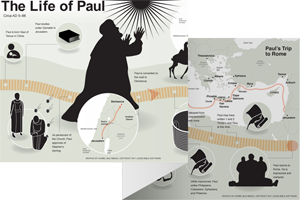1:1–5 The letter to the Galatians was written around ad 48–55 by the Apostle Paul, perhaps with contributions from some of his fellow missionaries (Gal 1:1–2). |
1:1 Paul Formerly known as Saul of Tarsus (Acts 7:58; 9:11), Paul became an apostle of Jesus Christ and was a prominent figure in the growth of the early church (see note on Rom 1:1).
 Paul: A Life of Redemption and Transformation
Paul: A Life of Redemption and Transformation
an apostle See note on Ro 1:1.
not from men nor by men False teachers were accusing Paul of commissioning himself as an apostle; an illegitimate apostleship would discredit his preaching of the gospel and his missionary efforts (compare Gal 2:2). Paul distinguishes himself from the false teachers by emphasizing that God and Christ—not humans—sent him as an apostle.
 Pauline Self-Designations Table
Pauline Self-Designations Table
1:2 brothers with me Paul often mentions his coworkers at the beginning of his letters (e.g., 1 Cor 1:1; 2 Cor 1:1; Phil 1:1; Col 1:1; 1 Thess 1:1; Phlm 1). Here Paul refers to several believers without naming specific individuals, perhaps to highlight the strong support he had from the community of believers.
Galatia A region in central Asia Minor (modern-day Turkey).
Paul visited several cities in the region of Galatia during his missionary journeys. While the number of churches Paul addresses in Galatians is unknown, the letter suggests they were predominantly Gentiles—that is, non-Jews (Gal 2:8, 14; 4:8–9; 6:13). The exact location of Galatia remains uncertain. It might refer to the territory in north-central Asia Minor inhabited by the Gauls beginning in the third century bc, or the southern area of Asia Minor that Paul visited during his first missionary journey. |
1:3 Grace to you and peace This brief greeting summarizes Paul’s gospel message. It is God’s work, through Christ on our behalf, that brings us into a harmonious relationship with God and one another.
1:4 gave himself for our sins Refers to Jesus’ sacrificial death on the cross.
present evil age Jewish people divided history into two major sections: the present age, in which God’s rule is not fully established (and evil persists), and the coming age, when God will complete His rule as King. For Christians, the sacrificial death of Christ enables believers to live under God’s rule in the present age. For this reason (and others), the deeds Paul affiliates with the flesh (sinful acts) are inappropriate for the people of God (Gal 5:19–21).
1:5 glory forever and ever. Amen Expresses the conviction that God is worthy of our unending adoration and worship. The word “amen,” meaning “so be it,” is used to show agreement or endorsement of what is said about God.
1:6–10 At this point in his letters, Paul typically offers a prayer of thanksgiving for his audience (Rom 1:8; 1 Cor 1:4; Phil 1:3). But with the Galatians, there is no cause for thanksgiving; they have turned to a different gospel. |
 Prayers in Paul’s Letters Table
Prayers in Paul’s Letters Table
1:6 the one who called you Refers to God, not Paul (Gal 5:8).
1:7 some who are disturbing you The false teachers in Galatia probably presented their message as the true understanding of the gospel. According to Paul, these teachers have done more harm than good. All of Paul’s descriptions of them are negative (vv. 7; 5:10, 12). The identity of these teachers is unknown, and their affiliation with the leaders of the church at Jerusalem remains uncertain. They probably are Judaizers (see note on 2:14).
1:8 even if we or an angel Paul probably writes hypothetically here; neither he nor an angel from heaven would ever proclaim a different gospel.
accursed The Greek word used here, anathema, refers to putting someone under God’s judgment. Since the gospel is the message of God’s salvation, God will punish those who distort it.
 Anathema Word Study
Anathema Word Study
1:10 seeking to please Paul was being accused of easing the requirements of obedience to the law for Gentile believers (non-Jewish people who believed in Jesus). For example, while circumcision was a sign of God’s covenant with Abraham (Gen 17), Paul did not require that Gentile believers be circumcised. This made his message more appealing to Gentiles while opening him to the charge of seeking to appease people.
1:11–24 Paul’s accusers probably claimed that his independence from the leaders at Jerusalem made him a rogue minister. In this section, Paul challenges this assessment. He says that, despite his independence, the leaders at Jerusalem supported his call and gospel, confirming the legitimacy of his ministry. |
1:11 not of human origin Paul began the letter with a defense of his apostleship—it came from God, not people. His argument here is similar, but this time it is not about himself, but his gospel.
1:13 former way of life Before his encounter with the risen Christ on the road to Damascus, Paul was a strict Jew and zealous opponent of Christianity (Acts 7–9; 22:2–11; Phil 3:1–15).
1:14 traditions handed down by my forefathers Refers to Pharisaic traditions that likely include the Jewish law as well as oral traditions concerning its interpretation (compare Mark 7:5; Acts 22:3).
1:15 one who set me apart The ot prophets Jeremiah and Isaiah described their callings in similar ways (Jer 1:5; Isa 49:1). This phrase signals that Paul’s ministry is a continuation of God’s work and voice in the world.
1:16 to reveal his Son in me The end of this phrase is often translated “to me,” but it is better understood as “in me.” Paul emphasizes that God chose him as an instrument to take the gospel to the Gentiles. Paul did not need human approval of his gospel since God Himself revealed His son and the gospel in him (see Acts 26:17, 20, 23).
among the Gentiles Paul directed his ministry primarily to the non-Jewish people (Acts 9:15; 22:21). He considers his missionary work a fulfillment of what God spoke through the prophet Isaiah about being a light to the Gentiles (Acts 13:46–47; Isa 49:6).
1:17 Arabia In this context, the reference is most likely to the southeast area of Damascus called Nabatea. However, in Graeco-Roman sources of this era, the term “Arabia” was used broadly, referring to southern Canaan (Israel), the northern Sinai, and Midian. See Gal 4:25.
was used broadly, referring to southern Canaan (Israel), the northern Sinai, and Midian. See Gal 4:25.
1:18 after three years By specifying the length of time, Paul is offering support for his claim that the apostles did not teach him the gospel in Jerusalem; rather, his revelation of the gospel came directly from Jesus Christ.
Cephas Refers to Simon Peter, an apostle of Jesus and one of the key leaders of the church at Jerusalem. Paul acknowledges that he met Cephas, but he emphasizes that he did not learn the gospel from him.
1:19 James The brother of Jesus who became the leader of the church at Jerusalem.
of Jesus who became the leader of the church at Jerusalem.
1:21 Syria and of Cilicia Syria lies directly north of Galilee
lies directly north of Galilee and includes the cities of Antioch
and includes the cities of Antioch (Acts 11:19–30), Damascus (Acts 9:1–19), and Caesarea Maritima.
(Acts 11:19–30), Damascus (Acts 9:1–19), and Caesarea Maritima. Cilicia
Cilicia is the region west of Syria, and includes Paul’s home city of Tarsus.
is the region west of Syria, and includes Paul’s home city of Tarsus.
Event | Approximate Date |
Paul’s conversion | ad 33 |
Paul in Arabia | ad 33–35 |
Paul’s visit to Jerusalem | ad 35 |
Paul in Syria and Cilicia | ad 35–48 |
1:22 I was unknown in person During the persecution in Jerusalem recorded in Acts, many believers fled to Judaea and Samaria (Acts 8:1). Since Paul participated in the persecution, his victims would have warned other believers about him.

|
About Faithlife Study BibleFaithlife Study Bible (FSB) is your guide to the ancient world of the Old and New Testaments, with study notes and articles that draw from a wide range of academic research. FSB helps you learn how to think about interpretation methods and issues so that you can gain a deeper understanding of the text. |
| Copyright |
Copyright 2012 Logos Bible Software. |
| Support Info | fsb |
 Loading…
Loading…





 Galatia
Galatia